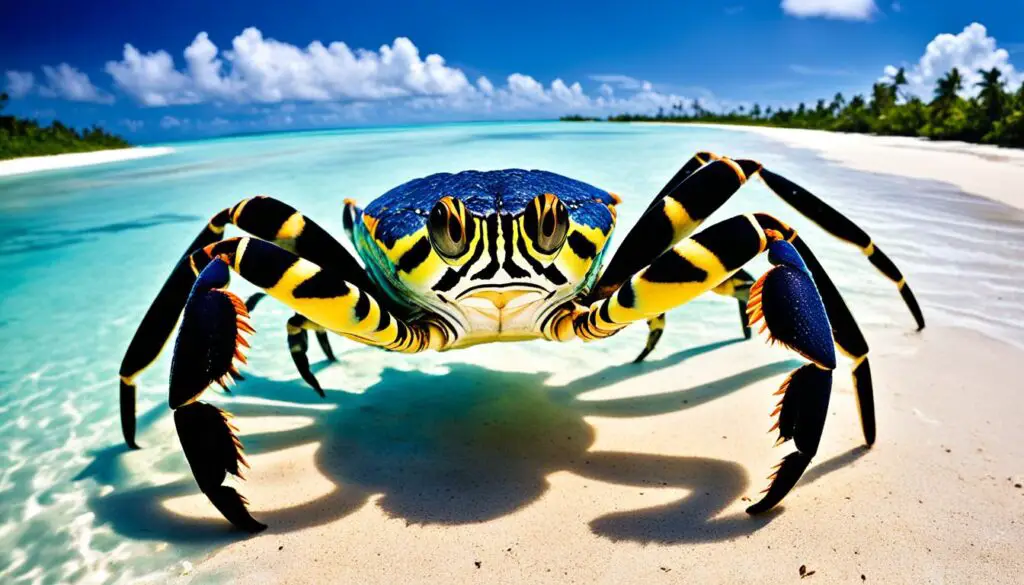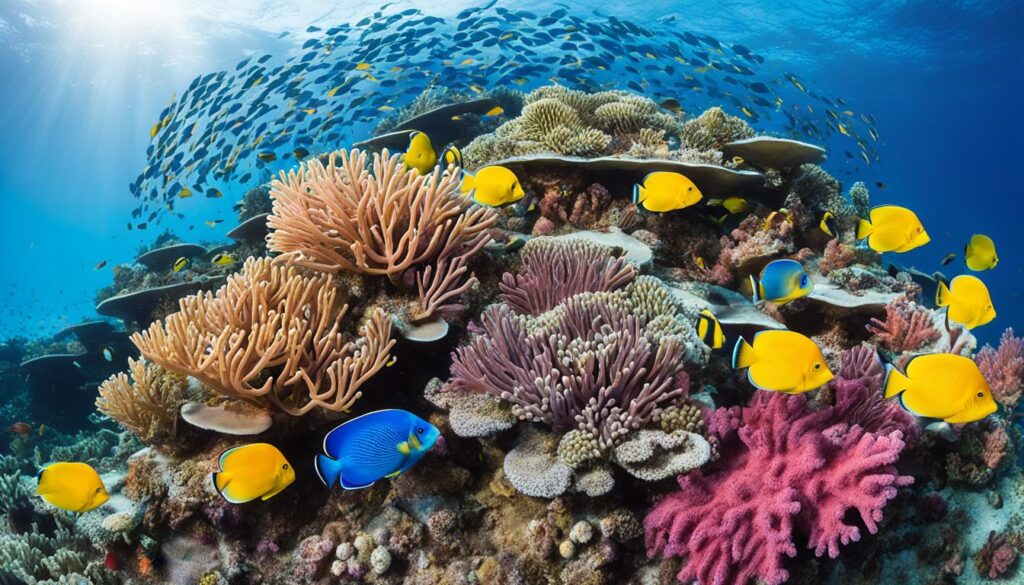Did you know that Kiribati, a Pacific Island nation, is home to a staggering diversity of wildlife? From birds and reptiles to marine life and invertebrates, Kiribati boasts a rich array of native animal species. Efforts are being made to protect and conserve these unique creatures and their habitats, ensuring their survival for future generations.

Key Takeaways:
- Kiribati is a Pacific Island nation with a rich diversity of wildlife.
- The country is home to a variety of animal species, including birds, reptiles, fish, and invertebrates.
- Endangered bird species and marine turtles are among the unique animals found in Kiribati.
- Conservation efforts are underway to protect and preserve the native animal species of Kiribati.
- Kiribati aims to establish animal sanctuaries to provide a safe haven for its wildlife.
Birds of Kiribati
Kiribati is a haven for birdwatchers, with 90 recorded bird species. Among them, two are endemic to Kiribati – the Henderson petrel and Kiritimati reed-warbler. Unfortunately, both are endangered. The Kiritimati Sandpiper, another native bird species, is now extinct. Efforts are being made to protect these bird species and their habitats.
The diverse bird species in Kiribati make it a paradise for bird enthusiasts. The unique geographical location and rich ecosystem provide a diverse habitat for a wide range of native and migratory bird species. Here are some notable bird species found in Kiribati:
| Bird Species | Status |
|---|---|
| Henderson petrel | Endangered |
| Kiritimati reed-warbler | Endangered |
| Kiritimati Sandpiper | Extinct |
These bird species play a vital role in the ecosystem of Kiribati, contributing to pollination, seed dispersal, and insect control. The endangered status of the Henderson petrel and Kiritimati reed-warbler highlights the urgent need for conservation measures to protect their habitats and enhance breeding programs.
Conservation organizations and local initiatives are working tirelessly to raise awareness about the importance of preserving bird species in Kiribati. These efforts include habitat restoration, predator control, and community engagement. Through these initiatives, there is hope for the recovery and protection of Kiribati’s unique bird species for future generations to appreciate and enjoy.
Reptiles of Kiribati
Kiribati, with its stunning marine ecosystems, is home to a diverse array of reptiles. Among the reptile species found in Kiribati, the most notable are the Green turtle and Hawksbill turtle, both of which are marine turtles. These magnificent creatures are highly valued and cherished in the local culture.
While Green turtles and Hawksbill turtles are the confirmed species observed in Kiribati, there have been reported sightings of other turtle species. These sightings include the Loggerhead sea turtle, Olive ridley, and Leatherback, although positive identification has not been established.
Reptiles, particularly marine turtles, play an essential role in maintaining the balance of Kiribati’s fragile ecosystems. As keystone species, they contribute to the health and sustainability of the surrounding marine life, including coral reefs and other vulnerable habitats.
Efforts are underway to protect and conserve the reptile species in Kiribati, including the establishment of marine protected areas and initiatives to reduce pollution and illegal trade. These conservation efforts are crucial for preserving the unique biodiversity of Kiribati and ensuring the long-term survival of these reptiles.

By raising awareness, implementing sustainable practices, and fostering collaboration between local communities, government agencies, and conservation organizations, Kiribati aims to create a harmonious coexistence between humans and reptiles, protecting these fascinating creatures for generations to come.
| Reptile Species | Status |
|---|---|
| Green turtle | Endangered |
| Hawksbill turtle | Critically Endangered |
| Loggerhead sea turtle | Reported sightings |
| Olive ridley | Reported sightings |
| Leatherback | Reported sightings |
Fish of Kiribati
The waters around Kiribati are home to a diverse and vibrant array of fish species, contributing to the rich marine life of the region. With approximately 500 fish species, particularly in the Phoenix Islands, Kiribati offers a haven for underwater enthusiasts and researchers alike.

Among the unique fish species found in Kiribati are the triggerfish, candy scale picnic gobies, and y-barred sandperch. These native fish species have adapted to the local marine ecosystem, playing important roles in maintaining the balance and biodiversity of Kiribati’s waters.
Triggerfish
Known for their vibrant colors and unique body shapes, triggerfish are a prominent sight in the waters surrounding Kiribati. From the Picasso triggerfish with its striking black, white, and yellow patterns to the Humbug triggerfish with its distinctive black and white stripes, these fish species add beauty and diversity to Kiribati’s marine life.
Candy Scale Picnic Gobies
Candy scale picnic gobies, also known as Allocheiria travalas, are small and docile fish species found in Kiribati’s coral reefs. Recognizable by their colorful patterns and intricate scale designs, these gobies are a delight to observe for snorkelers and scuba divers exploring the underwater wonders of Kiribati.
Y-Barred Sandperch
The y-barred sandperch, scientifically known as Parapercis ypsiloides, thrives in the sandy areas near coral reefs. These fish possess a unique ability to bury themselves partially in the sand, camouflaging themselves from potential predators. Their distinct y-shaped pattern on the sides of their bodies makes them easily identifiable.
As Kiribati continues its commitment to preserving its native fish species and the marine life that surrounds its islands, the conservation efforts place a strong emphasis on sustainability and responsible practices. By safeguarding these fish species and their habitats, Kiribati ensures the preservation of its precious marine biodiversity for future generations to enjoy.
Invertebrates of Kiribati
Kiribati, with its stunning coral reefs, is home to a diverse array of invertebrates. These invertebrates, including various species of coral, play a crucial role in maintaining the health and balance of the marine ecosystem in Kiribati.
The vibrant coral reefs found in Kiribati, particularly in the Phoenix Islands, provide a vital habitat for around 200 species of coral. These coral reefs, teeming with life, support a rich diversity of invertebrates such as sea anemones, jellyfish, sea stars, and crustaceans.
Importance of Coral in Kiribati
Coral reefs are not only visually stunning but also serve as crucial nurseries and habitats for a wide variety of marine life. They provide shelter, food, and protection to many invertebrate species, as well as fish and other marine organisms.
The coral reefs of Kiribati are not only home to the invertebrates themselves but also serve as a foundation for the entire marine ecosystem. They support the survival and reproduction of various fish species, provide feeding grounds for turtles, and contribute to the overall biodiversity of the region.
Unfortunately, coral reefs around the world, including those in Kiribati, are under threat due to factors such as climate change, pollution, and unsustainable fishing practices. As a result, efforts are being made to protect and conserve these delicate ecosystems.
Conservation of Invertebrates in Kiribati
Kiribati recognizes the importance of preserving its invertebrate species and their habitats. Conservation organizations, local communities, and the government are working together to implement measures aimed at safeguarding the coral reefs and the invertebrates they support.
Conservation efforts include the establishment of marine protected areas and the promotion of sustainable fishing practices. Additionally, initiatives are being undertaken to raise awareness about the importance of coral reefs and invertebrates in Kiribati’s marine ecosystem.
Through these conservation efforts, Kiribati aims to ensure the long-term survival of its invertebrate species, protect the delicate balance of its marine ecosystem, and maintain the natural beauty that makes the country a true paradise for nature enthusiasts.
Conservation Efforts in Kiribati
Kiribati recognizes the importance of conserving its unique animal species and their habitats. In order to protect and preserve the rich biodiversity of the nation, various conservation efforts are being implemented. These include:
- Conservation of Endangered Bird Species: Kiribati is actively working to protect and restore the populations of endangered bird species found on the islands. Through habitat preservation, monitoring, and research, these efforts aim to ensure the survival of these unique avian species.
- Marine Turtle Conservation: The conservation of marine turtles is a key priority in Kiribati. Through the establishment of protected areas and the promotion of sustainable fishing practices, the government aims to safeguard nesting sites and feeding grounds for the Green turtle and Hawksbill turtle populations.
- Preservation of Coral Reefs: Kiribati is home to diverse and vibrant coral reefs that support a wide range of marine life. The government is actively involved in the conservation and restoration of these ecosystems, employing measures to mitigate the impacts of climate change, pollution, and overfishing.
- Establishment of Animal Sanctuaries: Kiribati envisions the creation of animal sanctuaries to provide a safe haven for native wildlife. These sanctuaries would serve as protected areas where animals can thrive and where research and educational activities can take place.
By promoting sustainable practices and raising awareness about the importance of conservation, Kiribati strives to safeguard its unique animal species and preserve its natural heritage for generations to come.
Conservation Efforts in Kiribati
| Conservation Effort | Description |
|---|---|
| Protection of Endangered Bird Species | Implementing measures to preserve and restore populations of endangered bird species found in Kiribati. |
| Marine Turtle Conservation | Establishing protected areas and promoting sustainable fishing practices to safeguard nesting sites and feeding grounds for marine turtle populations. |
| Preservation of Coral Reefs | Actively involved in the conservation and restoration of coral reefs, implementing measures to mitigate the impacts of climate change, pollution, and overfishing. |
| Establishment of Animal Sanctuaries | Creating protected areas to provide a safe habitat for native wildlife and facilitate research and educational activities. |
Conclusion
Kiribati, a Pacific Island nation, is a treasure trove of diverse wildlife, making it a dream destination for nature enthusiasts. From its unique bird species to fascinating reptiles, vibrant marine life, and intricate coral reefs, Kiribati offers a rich tapestry of animal diversity.
Conserving and protecting these precious animals and their habitats is crucial for preserving Kiribati’s delicate ecological balance. The nation’s commitment to conservation efforts is evident through various initiatives aimed at safeguarding endangered species and their natural habitat.
Through the establishment of animal sanctuaries and ongoing conservation projects, Kiribati is working diligently to ensure the long-term survival of its wildlife. By prioritizing the preservation of its natural heritage, Kiribati is paving the way for future generations to appreciate and enjoy the beauty and wonder of its animal kingdom.
